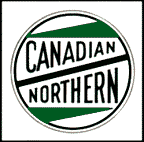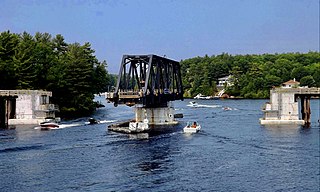History
The PSCR was formed in 1884 by the citizens of Parry Sound with the intention of encouraging a railway line to be built to the community.
On January 16, 1886, a public meeting was called in Parry Sound regarding a proposed railway line.
On February 5, 1886, a deputation waited upon the Ontario Government to ask for a subsidy to aid in construction of a line to Parry Sound. The Parry Sound line was described as being an important feeder for the Northern and Pacific Junction Railway (N&PJR), which was under construction at that time from Gravenhurst to Callander. The PSCR was to be built from Parry Sound in an easterly direction to connect with the N&PJR near Burks Falls. Beginning at Scotia Junction some work was done as far as Bear Lake before construction was halted due to lack of funds.
In 1892 the PSCR was acquired by Ottawa lumberman J.R. Booth and merged with his Ottawa, Arnprior & Parry Sound Railway which was being built from Ottawa to Georgian Bay. When Booth selected Depot Harbour as the western terminus of his railway, the citizens of Parry Sound felt betrayed.
Following acquisition of the PSCR by Booth, the locomotive from his Nosbonsing & Nipissing Railway was used for construction of this line, west of Bear Lake, during the winter months when that line was shut down for the season.

The Canadian Northern Railway (CNoR) was a historic Canadian transcontinental railway. At its 1923 merger into the Canadian National Railway, the CNoR owned a main line between Quebec City and Vancouver via Ottawa, Winnipeg, and Edmonton.

The Seguin River is a river in Parry Sound District in central Ontario, Canada that empties into Parry Sound on Georgian Bay, Lake Huron at the town of Parry Sound. The river's name comes from the Ojibwe word ziigwan, meaning "spring".

John Rudolphus Booth was a Canadian lumber tycoon and railroad baron. He controlled logging rights for large tracts of forest land in central Ontario, and built the Canada Atlantic Railway to extract his logs and to export lumber and grain to the United States and Europe. In 1892, his lumber complex was the largest operation of its kind in the world.
Depot Harbour is a ghost town on Wasauksing First Nation, in the Parry Sound District, Ontario, Canada. It was once the western terminus of the Canada Atlantic Railway and a busy port on Georgian Bay.
Seguin Falls is a ghost town and unincorporated place on the Nipissing Colonization Road in the township of Seguin, Parry Sound District in northeastern Ontario, Canada.

Swords is a ghost town and former railway point in central Ontario, Canada, in the township of Seguin in the District of Parry Sound.
The New York and Ottawa Railway was a railway connecting Tupper Lake in northeastern New York to Ottawa, Ontario, via Ramsayville, Russell, Embrun, Finch and Cornwall. It became part of the New York Central Railroad system in 1913, although it was under the larger company's possession since the end of 1904. It had started-out as the Northern Adirondack Railroad and evolved into the Northern New York Railroad, the New York and Ottawa Railroad, and was last known as the New York and Ottawa Railway before being merged into the New York Central and Hudson River Railroad. Other lines that were a part of this route are described below.

The Nosbonsing and Nipissing Railway (N&N) was a portage railway constructed by Ottawa lumber baron John Rudolphus Booth. The 5.5-mile (8.9 km) line connected Lake Nipissing with Lake Nosbonsing to allow lumber to be portaged onto the Mattawa River, and from there to the Ottawa River. It allowed timber from a wide area across central Ontario to be sent to Booth's mill in Ottawa, at that time the largest sawmill in the world.
The Ottawa, Arnprior and Parry Sound Railway, or OA&PS, is a historic railway that operated in central and eastern Ontario, Canada from 1897 until 1959. It was, for a time, the busiest railway route in Canada, carrying both timber and wood products from today's Algonquin Provincial Park areas, as well as up to 40% of the grain traffic from the Canadian west from Depot Harbour at Parry Sound through to the St. Lawrence River valley.
The Canada Atlantic Railway Company (CAR) was a historic North American railway located in Ontario, southwestern Quebec and northern Vermont. It connected Georgian Bay on Lake Huron with the northern end of Lake Champlain via Ottawa. It was formed in 1897 through a merger of three separate railway companies that John Rudolphus Booth had either purchased or created, beginning in 1879. The CAR was owned by Booth for eight years after its formation until he sold it to the Grand Trunk Railway (GTR) in 1904.

South Algonquin is a township municipality in Nipissing District, Ontario, Canada. Located south of Algonquin Provincial Park, it is the sole populated portion of the district that lies south of the traditional dividing line between Northern Ontario and Southern Ontario and is closer connected to Renfrew County as opposed to the core portions of Nipissing District.
The Northern and Pacific Junction Railway (N&PJ) is a historic railway located in northern Ontario, Canada. It connected the Northern Railway of Canada's endpoint in Gravenhurst to the Canadian Pacific Railway (CPR) at Nipissing Junction, near North Bay. The N&PJ provided an almost straight line north-south route from Toronto to the transcontinental line, competing with a similar line of the Canadian Northern Railway (CNoR) a short distance to the east.
Girvan and Portpatrick Junction Railway (G&PJR) was a railway company in Scotland. It opened in 1877 between Girvan and Challoch Junction, where it joined the Portpatrick Railway, which had already reached Stranraer from Castle Douglas. Portpatrick had been an important ferry terminal for traffic to and from the north of Ireland, but its significance was waning and Stranraer assumed greater importance. The new line formed part of a route between Glasgow, Ayr and Stranraer.

The Wasauksing Swing Bridge spans the South Channel, a narrow channel of Georgian Bay between the Rose Point on the mainland and an island commonly known as Parry Island, near Parry Sound, Ontario.
The Georgian Bay and Seaboard Railway (GB&S) was a former short-line railway in Ontario, Canada, owned and operated by Canadian Pacific Railway (CPR). The first sections opened in 1908, and the entire 140 kilometres (87 mi) route was fully completed in 1912.
The Irondale, Bancroft and Ottawa Railway (IB&O) was a short line railway in Central Ontario, Canada. The line was originally opened in 1878 as the Myles Branch Tramway, a horse-drawn wagonway connecting the Snowdon Iron Mine to the Victoria Railway a few miles away. The line was taken over by a group looking to build a northern extension of the Toronto and Nipissing Railway (T&N) as the Toronto and Nipissing Eastern Extension Railway. This extension was never built; instead, the company rechartered as the IB&O and used the Tramway as the basis for a new line with the ultimate aim to connect Orillia to the Ottawa area.

The Whitney and Opeongo Railway (W&OR) was a former logging railway in Ontario, Canada. It ran from Opeongo Lake to Whitney, where it connected to the Canada Atlantic Railway (CAR), running a total distance of about 14 miles (23 km). It opened in 1902 and closed in the 1920s with the end of major logging operations in the area.
The Egan Estates Railway, also known as the McCauley Central Railway, was a private logging railway in central Ontario, Canada. It ran northwest off the Ottawa, Arnprior and Parry Sound Railway (OA&PS) from a junction about 4.5 miles (7.2 km) northwest of the town of Madawaska. The line originally ran about 5 miles (8.0 km) to McCauley Lake, but was later extended another 10 miles (16 km) into the bush near Kitty Lake.

The Canadian National Railway Bala Subdivision is a major railway service line in Ontario running between the provincial capital of Toronto in Southern Ontario and Capreol in Northern Ontario, where the line continues as the Ruel Subdivision. It forms part of CN's transcontinental mainline between Southern Ontario and Western Canada.









